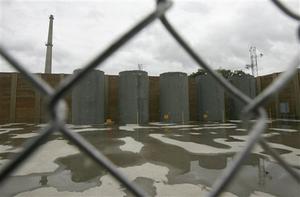Nuclear mattersCooling pools or dry casks for nuclear waste: which is safer
There are two ways to store nuclear waste: in pools of water, where the densely packed uranium rods are cooled by a constant flow of circulating water, or in dry casks — typically barrel-shaped steel-and-concrete structures that stand twenty feet high and sit outdoors — where the uranium loosely packed rods are cooled by passive air; there are 65,000 tons of nuclear waste in the United States, more than in any other nation, and this amount grows by about 2,200 tons each year; the Fukushima disaster demonstrated that dry casks were able to withstand the 11 March combination of earthquake and tsunami much better than cooling pools; the U.S. Nuclear Regulatory Commission must now decide whether cooling pools are safe enough to store nuclear waste, and even whether densely packing nuclear waste is safe

Dry-cask storage at Vermont's Yankee nuclear plant // Source: cleveland.com
There are two ways to store spent nuclear fuel:
- in pools of water, where the densely packed uranium rods are cooled by a constant flow of circulating water
- in dry casks — typically barrel-shaped steel-and-concrete structures that stand twenty feet high and sit outdoors – where the uranium loosely packed rods are cooled by passive air
Data from the Nuclear regulatory Commission (NRC) shows that of eighty-four current or former U.S. reactor sites holding spent fuel – note that this figure includes some sites with more than one nuclear power plant – sixty-three already have dry casks, ten are applying to build them, and eleven have not yet made clear what their plans are.
Technology Review reports that one lesson of the Fukushima disaster is that dry casks were able to withstand the 11 March combination of earthquake and tsunami much better than cooling pools. Ron Ballinger, an MIT nuclear engineer, told TR that “What will likely happen very quickly is that the [Nuclear Regulatory Commission] and utilities will arrive at a consensus that moving fuel to dry storage needs to be accelerated to get as much spent fuel out of the pools as fast as possible,” says. In Japan, he says, “the dry storage casks weathered the earthquake and tsunami with zero problems.”
There are 65,000 tons of nuclear waste in the United States, more than in any other nation, and this amount grows by about 2,200 tons each year. In the wake of Fukushima, the NRC must now decide whether cooling pools are safe enough to store nuclear waste, and even whether densely packing nuclear waste is safe.
“In general, U.S. reactors have a great deal more fuel in their spent-fuel-pools than the reactors at Fukushima,” Richard Lester, who heads the Department of Nuclear Science and Engineering at MIT, told TR. If a Fukushima-scale event were to strike a typical U.S. nuclear plant fuel pool, he says, “I think you would potentially have a worse situation simply by virtue of there being more fuel — a lot more fuel in the cases of the pools at the U.S. reactors.”
A 2003 report on the subject said that in the event of coolant loss in a densely packed pool, air cooling would not suffice. Temperatures could rise to 600 °C within an hour, causing the zirconium fuel cladding to rupture, and then increase to 900 °C, when the cladding would burn, resulting in huge quantities of released radioactive material, the report said.
Allison Macfarlane, a geologist and associate professor of environmental science and policy at George Mason University, was one of the coauthors of the 2003 report. She told TR that “A lot of these pools are in upper stories at the power plant,” meaning breaches or cracks could let water run out. “If there is a loss of water, you can have a release of radioactivity much larger than Chernobyl, because there is a lot more fuel in the pool than in the core of the reactor.”
A 2006 National Research Council report also said the fire scenarios required more study, and suggested other measures while leaving dense configurations intact. “It appears to be feasible to reduce the likelihood of a zirconium cladding fire by rearranging spent fuel assemblies in the pool and making provision for water-spray systems that would be able to cool the fuel, even if the pool or overlying building were severely damaged,” the report said. Fuel rearranging and backup cooling of pools are being implemented, an NRC spokesman told TR.
In 1982 the United States announced plans to create a national, centralized dry-cask storage facility in Yucca Mountain, Nevada. A year-and-a-half ago the Obama administration began to de-fund the project, all but ensuring its demise.
Some now say that it may well be the case the one of the results of the Fukushima disaster would be revisiting this decision, and including the Yucca Mountain nuclear repository project again in the conversation about a safe solution for the U.S. nuclear waste.
